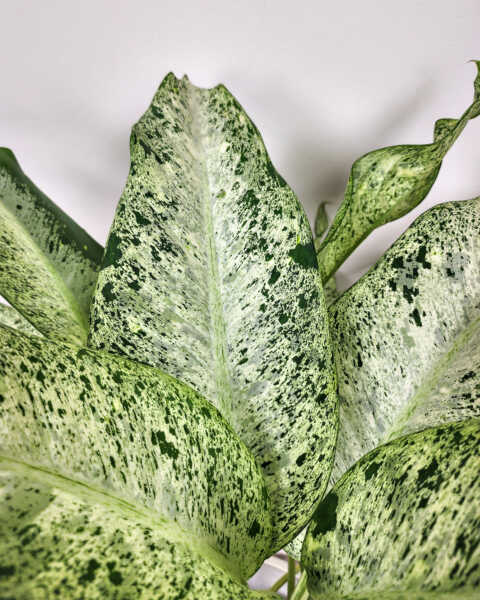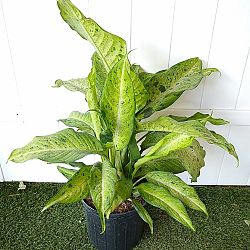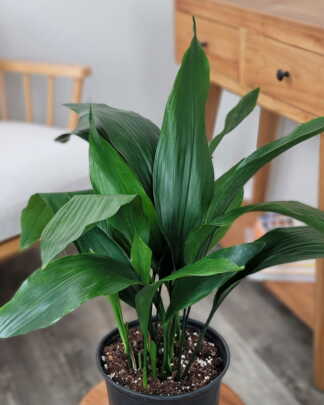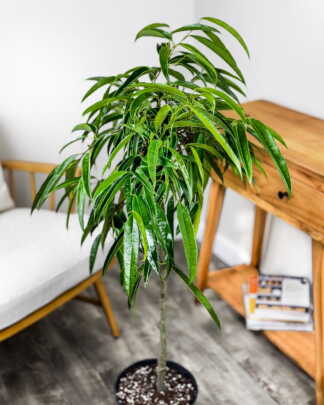Description
You are Going to Want to see This!
Introduce a touch of tropical elegance to your indoor plant collection with the Dieffenbachia ‘Camouflage’. This exotic houseplant stands out with its large, glossy leaves, painted with a unique mix of green shades, cream, and white, creating a captivating ‘camouflage’ effect.
Caring for your Dumb Cane
Dumb Cane, or Dieffenbachia, is a popular choice for indoor gardening due to its lush, tropical foliage and relatively easy care. Care for the Dieffenbachia involves moderate watering and occasional feeding during the growing season. With its visually pleasing foliage and low-maintenance needs, it’s a perfect choice for elevating your interior décor while also promoting a healthier living space.
Light
Dieffenbachia plants prefer bright, indirect light. They can tolerate lower light conditions, although their growth might slow and their variegated leaves can become more green. However, too much direct sunlight can scorch the leaves, leaving them with unsightly brown spots. If you’re growing Dumb Cane indoors, placing it near an east or north-facing window is usually ideal. For south or west-facing windows, use blinds or curtains to filter the intense afternoon sun.
Temperature
As a tropical plant, Dieffenbachia prefers warmer temperatures. A range between 60°F (15°C) to 75°F (24°C) is typically ideal. It’s important to avoid drastic temperature changes, which can stress the plant. Therefore, keep the plant away from drafts, air conditioners, or heating vents.
In terms of humidity, Dumb Cane prefers higher levels, reflecting its natural rainforest habitat. While it can adapt to average indoor humidity, the plant will appreciate additional humidity, especially during dry winter months. This can be achieved by using a humidifier, placing a tray filled with water near the plant, or grouping plants together.
Water
Dieffenbachia likes a moderate amount of water. During the growing season (spring and summer), keep the soil consistently moist but not soggy. Overwatering can lead to root rot, a common issue with houseplants. A good rule of thumb is to let the top inch of the soil dry out between waterings.
In terms of feeding, a balanced, water-soluble houseplant fertilizer can be applied every four to six weeks during the growing season. This provides the nutrients needed for healthy growth and vibrant foliage. Always follow the manufacturer’s instructions regarding dilution rates, as over-fertilization can damage the plant.
Soil
The ideal potting mix for Dieffenbachia is one that is well-draining and rich in organic matter. A high-quality potting soil mixed with some perlite or coarse sand is usually a good choice. Repotting is generally needed every 2-3 years or when the plant outgrows its current pot. When repotting, it’s a good opportunity to check the roots for signs of overwatering or disease.
Pruning and Propagation
Pruning your Dumb Cane helps maintain its shape and size. You can also remove any yellowing or diseased leaves to improve the plant’s overall health. Always use clean, sharp scissors or pruning shears to make clean cuts.
Dieffenbachia can be easily propagated by stem cuttings. To do this, cut a piece of stem that is 4-6 inches long and contains at least one node. You can place the cutting in water until roots form, then plant it in potting soil.
Pest and Diseases
Dieffenbachia is relatively hardy but can occasionally be affected by pests such as spider mites, aphids, and mealybugs. These pests can be controlled using insecticidal soap or neem oil. Always isolate an infected plant from others to prevent the spread of pests.
Overwatering or poor drainage can lead to root rot, a common disease. Signs of this include yellowing leaves and a foul smell coming from the soil. If this occurs, repot the plant, removing any diseased roots, and ensure you adjust your watering routine.
Dieffenbachia is toxic if ingested and can cause irritation upon skin contact. The plant should be kept away from pets and children. If skin contact occurs, wash the area thoroughly with soap and water.
















Lauren G. (verified owner) –
A lot bigger than I thought he would be and so pretty! Packaged with the utmost care. I would definitely shop here again. Great, healthy plant!!
Melisa A Schilling (verified owner) –
Virginia G (verified owner) –
Jacqueline Baker –
The leaves of my dieffenbachia is turning brown at the ends an sagging. What am I doing wrong? Help